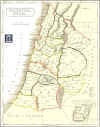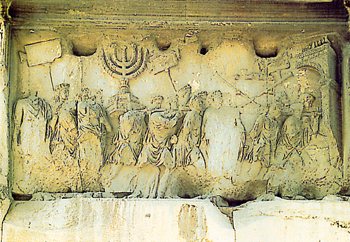|
|||
|
During the past 2,000 years, European Jews have migrated extensively. From Portugal to Turkey, Jews have been attacked, banished, and forced to choose between death and converting to the prevailing religion. Homes and buildings of worship have been destroyed. Jewish people have moved away from hostile situations, sometimes voluntarily but very often by force, in search of more tolerant communities... The Jewish homeland originally was the land of Israel...
1st century Arch of Titus relief depicting the sack of Jerusalem
In 70, the Romans destroyed the Second Temple in Jerusalem. A large part of the Jewish population was either massacred or exiled. In Judea, the area near present day Israel, 25% of the Jewish population was exterminated and 10% enslaved. Jews became a minority in their own land. Eventually, Jewish people were scattered across thousands of miles. This is known as the Diaspora, a word with Greek roots meaning “scattering” or “to scatter about”.
Many Jews fled to Mesopotamia, which is modern Iraq, and the rest fled to lands around the Mediterranean, presently known as southeastern Spain, southern France, southern Italy, Greece, Cyprus, and Turkey. Later, the Jews began to head north (to present day northern France, Belgium, Holland, Germany, Austria, Bulgaria, and Bosnia) and northern Africa (to Egypt, Libya, Tunisia, Algeria, Morocco). By 300, about three million Jews had settled in most parts of the Roman Empire, except Britain. A million lived west of Macedonia (Greece) with the majority settling throughout Asia Minor and east to the Caspian Sea and the Persian Gulf. Jews lived as far north as Cologne, Germany. In 312, Constantine gave Christianity status as the official religion of the Roman Empire. During the next three centuries, invading Ostrogoths, Visigoths, Vandals, Huns, Franks, and Burgundians created a violent, unjust, and impoverished Europe. The Jews were treated as poorly as the rest of the population. Discrimination against the Jews was written into laws prohibiting Jews from holding high position in government, intermarrying with Christians, appearing as witnesses against Christians, and owning slaves. Converting to Judaism was also forbidden. Beginning in the mid-8th century, along the southern and western rim of the Mediterranean Sea and east beyond the Caspian Sea, Jews were widely tolerated and accepted under Islamic rule. The Muslims granted Jews and Christians exemption from military service, the right to their own courts of law, and a guarantee of the safety of their property. Islamic territory included present day Iran, Iraq, Turkey, western Russia, the Saudi Arabian peninsula, northern Africa, and, in Europe, Spain, Sicily, and Sardinia. Jews experienced a Golden Age. Jewish poets, scholars, scientists, statesmen, philosophers flourished within and were an integral part of the Arab civilization. For hundreds of years, Jews and Arabs lived together in peace and with mutual respect. In the middle of the 12th century, this Golden Age of the Muslim Empire and the Jewish Golden Age in Spain ended. Generally, Jews were relatively free and moderately prosperous in Europe during the early Middle Ages. Pope Gregory the Great (591) forbade the forcible conversion of Jews. Both Theodoric the Great (454-526), ruler of Italy, and Charlemagne (742-814), the ruler of France and western Germany, invited Jews to live within their kingdoms, mostly for economic reasons. In 1066, William the Conqueror welcomed Jews to England. Jews were outside the feudal system and could not be tied to land nor belong to craftsmen’s guilds. Because Christianity forbade the lending of money with interest, Jews became money lenders, and were valuable as the merchants and financiers of Christian Europe. With the end of feudalism, Christians claimed the economic functions that the Jews had previously held. The Church also became less tolerant of religious freedom. The Crusades were fought with the idea of freeing the Holy Land and turning Jerusalem into a Christian shrine. As part of this religious zealotry, all kind of heretics (Jews, Muslims, scientists and suspect Christians) became the enemy within Europe. There were eight Crusades, the first in 1095; the last Crusade was from 1270-72. Many Jews fled east from areas of present day Spain, France and Germany to Poland and Lithuania. The Jews continued to have a very difficult time in Europe during the later portion of the Middle Ages... In 1215, the Fourth Lateran Council, called by Pope Innocent III, decreed that Jews must wear special dress, badges or distinctive conical hats to distinguish them from other people. Expulsions of Jews continued throughout the continent. The first of many ritual murder charges started in 1144 in Norwich, England. Jews were charged with killing Christian children to use their blood for making unleavened bread (matzah) for Passover. Blood libels peppered Europe throughout the 12th and 13th centuries, as well as the 19th and 20th centuries. Jews were accused during the 13th through 16th centuries of desecrating the Host, the blessed bread distributed during the Eucharist... In 1243, in Belitz, Germany, profaning the Host was an excuse used for the first of a series of anti-Semitic massacres. Europe [suffered great] devastation in the 14th century: disastrous harvests, severe famine, and the Black Plague. Superstition and prejudice breed during dire times, and Jews were blamed for these hardships. Throughout Europe, the Jews were gradually confined in ghettos as the Middle Ages progressed. The first compulsory ones were established in Spain and Portugal at the end of the 14th century... Jews continued to flee eastward from Germany, Austria, and Hungary... Also during the High Middle Ages, Jews were leaving the area along the north shores of the Black Sea and heading northwest, into Poland, [where Jewish life came to flourish]. Polish rulers welcomed Jews during the 13th and 14th centuries, issuing [them] charters of legal rights... During the hundred years of the 15th century, the Jewish Polish population exploded from about 15,000 to 150,000. The Protestant Reformation began in 1521. The Reformation changed Europe, both socially and economically. Jews were welcomed into countries from which they had been expelled centuries earlier if it was in that country’s economic interest. In the words of historian Max Dimont: “The Western, Catholic, feudal countries did not want the Jews for religious reasons, and having no economic need of them, did not readmit them, whereas the Protestant countries, having an economic need of the merchant Jews, did readmit them.” Holland, beginning in 1579, allowed Jews to practice their religion freely, and a thriving Jewish community began to develop. Marranos were allowed to settle in England in 1655, and were never again expelled from England. For the three centuries from 1500-1800, in Germany and present day Austria, Jewish financiers were appointed to influential positions as financial ministers to the state, known as Court Jews. In 1780, in the Hapsburg territories of Austria, Hungary, and Bohemia and Moravia, Emperor Joseph II abolished the Jewish badge, and Jews were free to leave the ghetto, learn any trade, engage in commerce, and attend public schools and universities. The French Revolution bestowed citizenship on the Jews. In the 1700s Moses Mendelssohn, a Jewish German philosopher and essayist, encouraged Jews to leave the separate and insulated Jewish ghettos and assimilate into the German cultural community. During the 15th and 16th centuries, Poland became the center for Jewish learning. This prosperity continued until the second half of the 17th century when [there was a] series of massacres by Cossacks... Poland was pummeled by [a second] Cossack uprising, two invasions by Sweden, and a war with Turkey. In the 1700s, Poland was divided three ways, and [it] fell under the rule of Russia, Germany, and Austria. |


